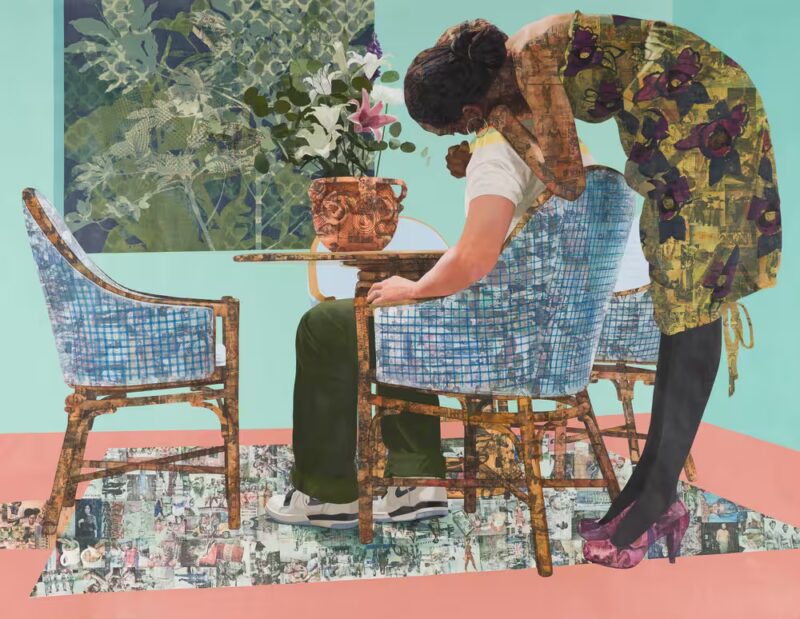The first image in Serena Meloche’s essay “All That Blue,” featured this month, is of a photo lab bathed in red light, glimpsed from behind a doorway. A girl watches on discreetly as her father dips blank film into solution, waiting for images of Mars to appear. That quiet moment, a doubled waiting, sets the tone for Guernica’s May issue: an issue about distance and intimacy, about what we observe in others when they do not know we are looking, and about what fills the open space between all of us when words fall short.
In “All That Blue,” Serena Meloche thus weaves together a father’s obsession with space, the failures of the Mars One project, a first love, and the grief that shadows a parent’s absence. This moving essay considers the galaxies we privately inhabit, and what it means to yearn for another world. Meanwhile, “Aquaduhka” by Victoria Livingstone is formally inventive and animated by a kind of sonic wonder. Through her daughter’s baby babble, the author explores “paradisiacal madness” in language and the possibility of a speech untethered from modern life’s confining strictures.
In Maz Do’s short story “Cut Blooms,” a young woman confronts her fraught bond with her sister, Rini, during a visit to their mother’s grave on the tenth anniversary of her death. Together, they pick at old wounds shaped by self-perception, rivalry, and a shared, painful past. Meanwhile, in Afabwaje Kurian’s “Between Sadness and Happiness,” a Nigerian-American woman returns to North Carolina to visit her grandfather while quietly contending with her marriage’s unraveling. This story about the uneasy pursuit of happiness is beautifully illustrated, courtesy of the artist, by the very painting that stands above the narrator’s desk: Njideka Akunyili Crosby’s Blend in, Stand out.
Our Global Spotlights selection, “Category Six” by Summer Eldemire, is a love story from Jamaica that moves through myth and memory. The storm at the story’s center defies all known categories, turning the island itself into a terrain as volatile as the emotional landscape that the characters navigate.
This issue also features two strikingly original works of poetry from Brazilian writers. The poems “I fall in love only with the furthest,” “I don’t want to come back here,” and “to write by chance the whiteness” by Annita Costa Malufe, translated by Janet Hendrickson, map the drift of thought across distances both physical and perceptual. And in “Jongo e Adriano,” a visual-poetic fotonovela by Yhuri Cruz, translated by Montana Ray, two Black lovers—one African-born, one a Brazilian criollo—flee slavery in 1820s Brazil in a story that both draws from and subverts the national heritage of concrete poetry.
Closing the May issue is “Awam Amkpa: And So On,” in which Guernica poetry editor Nathalie Handal interviews Nigerian director and scholar Awam Amkpa on his award-winning film The Man Died, inspired by Wole Soyinka’s 1971 prison notes on solitary confinement during the Nigerian Civil War. In a continuation of their 2024 conversation, “What’s Missing Will Be Found,” Amkpa reflects on the absent scenes in the film, as well as on Soyinka’s relationship to mathematics, mythoclastic approach to story, and impact on Nigerian society.
Finally, the May issue features original art by Yemisi Aribisala, Hyeseung Song, Jozie Furchgott Sourdiffe, Njideka Akunyili Crosby, and Awam Amkpa.
All the pieces in this issue resist a whole or indelible revelation; yet they leave a whole, indelible imprint on the reader. One emerges from them as if from a prolonged vigil behind a half-open door: spellbound and quietly changed by what one has seen appear.
–Youmna M. Chamieh, Editor-in-chief
—
“Between Sadness and Happiness”–
A woman’s visit to her grandfather becomes a journey of introspection and longing as she confronts her own impending divorce, generational and cultural differences, and the search for meaning in a life caught between sorrow and the elusive possibility of happiness. Exploring themes of family, grief, expectations, and loneliness, Kurian’s story captures the nuances of human relationships and the struggle to find contentment amidst life’s inevitable losses.
—
“Cut Blooms” –
In this story, a young woman grapples with her complicated relationship with her sister, Rini, as they visit their mother’s grave on the tenth anniversary of her death, uncovering layers of resentment, envy, and a shared history marked by love and cruelty alike.
—
“All That Blue” –
A father’s fascination with space, the betrayals of the Mars One project, a girl’s sexual awakening, and the grief that follows a parent’s loss all combine in this moving essay, which meditates on our lives’ private galaxies and what it means to long for another world.
—
“Aquaduhka” –
In this essay that is both formally inventive and playful in spirit, Victoria Livingstone explores the “paradisiacal madness” of her daughter’s baby babble, and its potential to unlock radical new paths in the face of capitalism’s “rigid and confining” instrumentalization of language.
—
“Category Six” –
From Jamaica, our Global Spotlight features a short story by Summer Eldemire. A love story spiraling through myth and memory, “Category Six” captures the emotional force of a storm that defies all known categories and turns the island itself into a character.
—
“Awam Amkpa: And So On” –
In a follow-up interview to “What’s Missing Will Be Found”, the Nigerian director Awam Amkpa discusses the missing scenes in his award-winning film The Man Died, inspired by Wole Soyinka’s 1971 prison notes on his solitary confinement during the Nigerian Civil War.
—
“I fall in love only with the furthest,” “I don’t want to come back here,” “to write by chance the whiteness” –
Three intimate poems by Brazilian writer and critic Annita Costa Malufe, mapping the drift of thought across distances both physical and perceptual. Translated from the Portuguese by Janet Hendrickson.
—
“Jongo e Adriano” –
An excerpt from Jongo & Adriano, a visual-poetic fotonovela by the Brazilian artist Yhuri Cruz in which two Black lovers—one African-born, the other a Brazilian criollo—flee enslavement together in 1820s Brazil. Translated from the Portuguese by Montana Ray.

